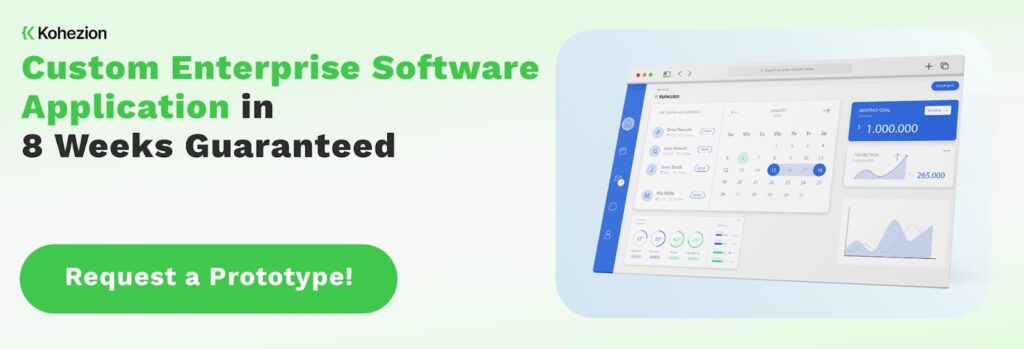Procurement software has become a game-changer, transforming how companies buy goods and services. Whether you're a small startup or a large enterprise, knowing about procurement software and its importance can revolutionize your operations. In this guide, we explore procurement software in detail, including its benefits, types, and key features.
We'll buid your first application for you. At no extra cost.
Let us build your first business application for free. Go from an idea to an application in under 2 weeks.
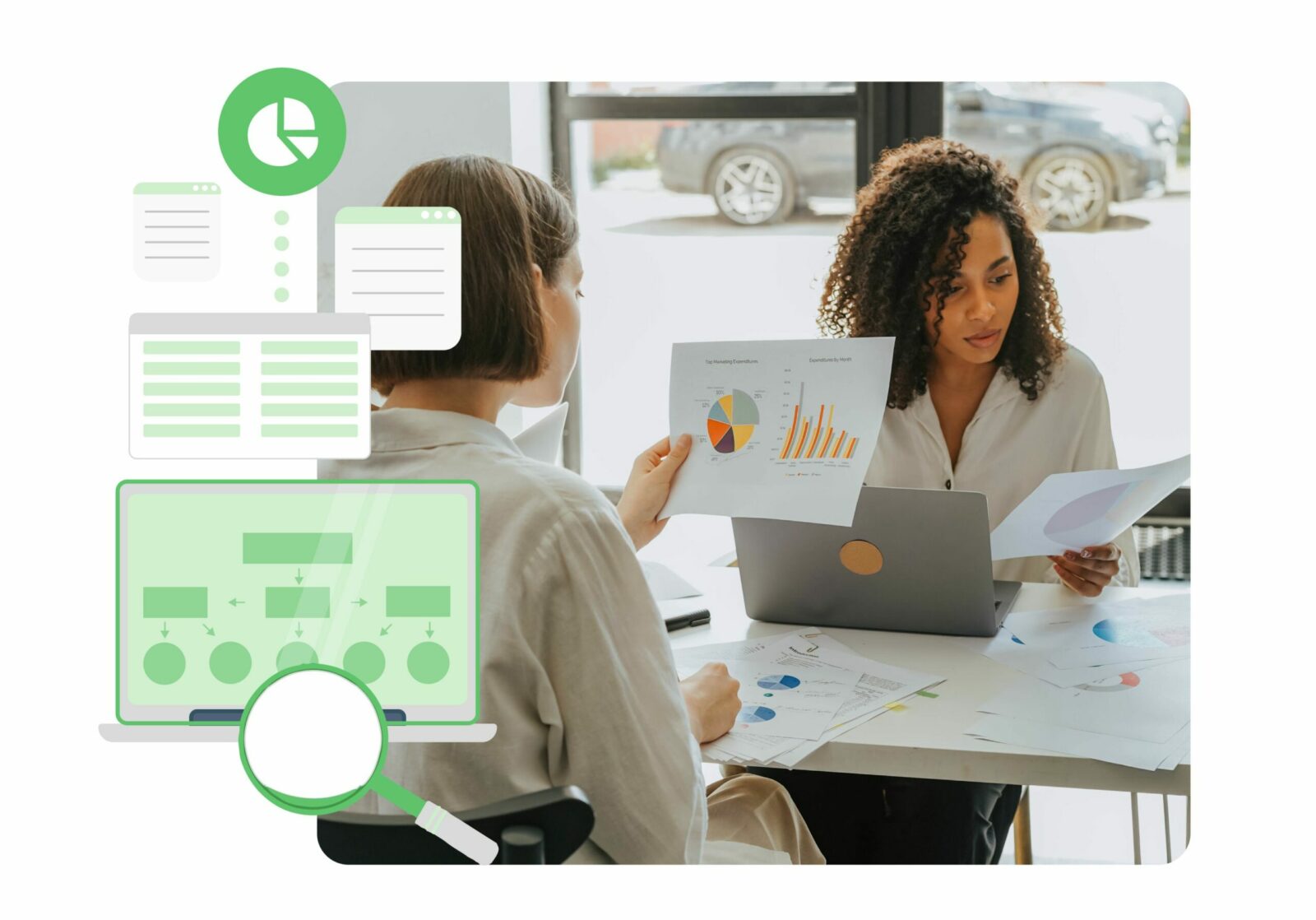
What Is Procurement Software?
Procurement software is a type of business software designed to streamline and automate the purchasing process within an organization. It helps businesses manage their procurement activities by providing tools for managing supplier information, creating and managing purchase orders, managing contracts, and tracking inventory. Procurement software can also provide data analytics to help identify cost-saving opportunities, manage supplier performance, and monitor compliance with procurement policies and regulations.
Procurement software is often integrated with an enterprise resource planning (ERP) system to keep the complete procure-to-pay cycle in one location. It can also be connected to other platforms like Oracle or SAP to facilitate uniform data management and real-time insights, empowering organizations to make informed decisions.
Procurement software also enforces consistency by ensuring all purchase requests (PRs) and purchase orders (POs) adhere to predefined company policies, routing them through the correct approval channels, and ultimately streamlining the procurement process from beginning to end.
Why Is Procurement Software Important for Your Business?
Procurement software optimizes your business operations and enhances overall efficiency. Implementing such software automates and streamlines procurement tasks, minimizing manual intervention and the risk of human error. Procurement software can perform the following tasks:
- Approve sales orders
- Select and order a product or service
- Receive and match an invoice and order
- Electronic bill payments
- Create a dashboard to highlight spending for the procurement department
- Combine several orders for the same type of good
- Set up supplier bidding for the business
Automating manual procurement processes can help businesses reduce costs, increase efficiency, and improve accuracy and transparency in the procurement process. This leads to a more efficient procurement process that can significantly impact your productivity and bottom line.
Cost Control: Procurement software helps businesses to effectively track spending, manage budgets, and control costs. The software consolidates purchase data, enabling procurement teams to negotiate better deals and identify opportunities to save money. According to statistics, organizations implementing procurement automation have achieved cost savings ranging from 15% to 40%.
Supplier Management: Managing supplier relationships becomes more systematic with procurement software. It helps monitor supplier performance, ensures that supplies are delivered on time, and fosters stronger partnerships through efficient communication and management tools.
Data Visibility: The software provides real-time visibility into procurement data that guides strategic decision-making. It also helps businesses ensure compliance with company policies and industry regulations by maintaining a clear, auditable trail of all procurement activities.
Using procurement software gives you a significant advantage over competitors who may still rely on manual methods, such as paper-based processes or spreadsheets.
Who Can Benefit from Procurement Software?
1. Finance teams
Procurement software can help finance teams manage their budgets more effectively by providing real-time visibility into spending and enabling them to track expenses more easily. Procurement software enables these teams to:
Implement Budget Management: They can enforce budget compliance with real-time budget tracking, quickly approving purchases within pre-set parameters and streamlining the procurement workflow.
Improve Spend Analysis: Finance professionals can evaluate spending patterns, spot trends, or identify cost-saving opportunities using the software’s detailed analytics.
Facilitate Accurate Forecasting: Better data means improved forecasting. Procurement software helps finance teams anticipate future expenses, resulting in more effective financial planning.
Increase Operational Efficiency: By automating procurement tasks, finance teams can focus on strategic activities rather than manual data entry and processing. This results in improved productivity and reduced potential for error.
2. Suppliers
Procurement software can make it easier for suppliers to do business with their customers by providing them with real-time information about purchase orders, invoices, and payments. This can help to reduce payment delays and improve cash flow. According to a survey by PayStream Advisors, 58% of suppliers reported that electronic invoicing has improved their cash flow. Here's how robust procurement software can help suppliers:
Streamlined Order Processing: Suppliers can quickly receive and process orders through an integrated system, which helps shorten order fulfillment times and reduces the chance of order errors.
Enhanced Communication: The software often includes communication tools that facilitate easy, direct communication between suppliers and buyers, ensuring clear requirements and quick resolution of queries.
Better Visibility and Forecasting: Procurement software allows suppliers to see upcoming orders or changes in demand, giving them more time to adjust their production schedules and inventory accordingly.
Self-Service Portals: Many systems feature supplier portals where suppliers can manage their information, submit invoices, and update order statuses, providing a sense of ownership and control over the process.
Faster Payment Processing: Transactions are recorded and processed through the software, so suppliers benefit from more timely payments, which is important for their cash flow management.
3. Executives
Procurement software can provide executives with valuable insights into their organization's spending patterns and help them identify saving opportunities. According to a report by Ardent Partners, organizations that use procurement software are 50% more likely to have a formalized spend analysis process. Here’s what executives stand to gain from procurement software:
Improved Decision-Making: Executives get access to accurate, real-time data that is critical for making high-level strategic decisions. This data informs procurement strategies, investment opportunities, and cost-cutting measures.
Risk Mitigation: Procurement software helps identify potential risks in the supply chain by monitoring supplier performance and compliance, allowing executives to take measures to mitigate these risks.
Increased Productivity: By automating routine procurement tasks, the software gives employees more time to focus on more strategic tasks, increasing productivity across the organization.
Enhanced Compliance and Governance: Executives can ensure corporate governance and compliance with industry regulations as the software maintains a complete, auditable record of all procurement activities.
Strategic Supplier Relationship Management: Procurement software enables executives to develop and maintain strategic relationships with key suppliers. This leads to preferential pricing, better terms, and innovations in products and services.
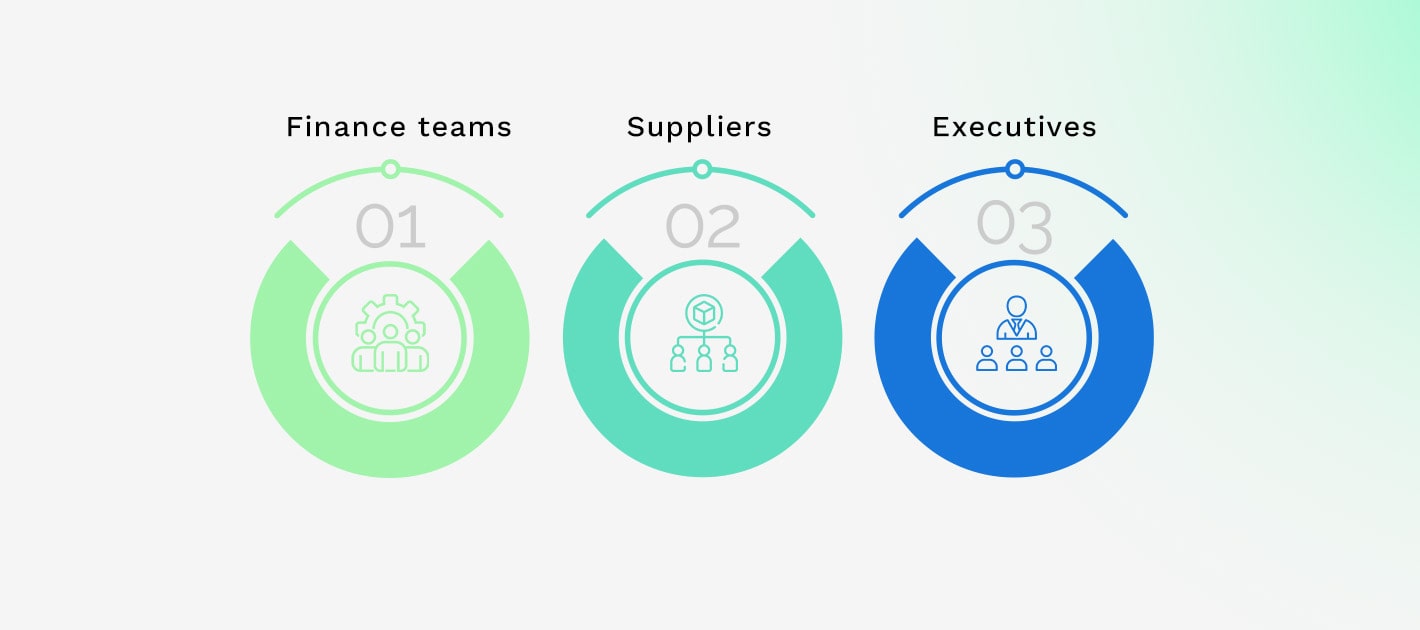
Types of Procurement Software
Spend Analysis System
A Spend Analysis System is a component of procurement software that scrutinizes and manages an organization's expenditure. It's designed to give a clear view of where the money goes and to identify patterns that could signify inefficiencies or opportunities for savings. Here's what it typically provides:
Data Collection: A Spend Analysis System aggregates purchasing data from various sources, ensuring a comprehensive spend profile.
Classification and Categorization: Transactions are categorized by supplier, department, or commodity, making it easier to spot trends and abnormal spending.
Analytical Tools: These systems offer analytical capabilities, allowing you to examine data for spending patterns and compliance with corporate policies.
Cost Reduction Insights: Highlighting areas of excessive spending or potential supplier consolidation enables businesses to negotiate better rates and terms.
Benchmarking and Forecasting: It helps compare spending against industry standards and predicts future spending scenarios to better prepare for negotiations and budgeting.
eProcurement Software
eProcurement software delivers a digital procurement experience, enabling organizations to conduct their purchasing activities online. It emphasizes ease of use, accessibility, and collaboration between purchasers and suppliers. Here's how eProcurement software serves businesses:
Streamlined Purchasing: It automates the procurement process from supplier selection and onboarding to order placement and management, making it faster and more efficient.
Catalog Management: Users can browse through electronic catalogs to select products and services, simplifying the purchase order process.
Requisition to Purchase Order Conversion: Automatic conversion of approved requisitions to purchase orders reduces manual workload and speeds up the purchasing cycle.
Approval Workflows: Customizable workflows ensure that each purchase request is reviewed and authorized following the company’s policies and hierarchy.
Supplier Integration: Good eProcurement software often allows for direct integration with suppliers' systems, facilitating real-time inventory checks and order placement.
Compliance and Control: It enhances procurement policy compliance and provides control over organizational spending through better visibility and tracking.
Purchase Order Software
Purchase Order (PO) Software targets the creation, management, and tracking of purchase orders. It reinforces the procurement process by bringing automation and centralized control to purchasing actions. Here are the functionalities PO software offers:
Purchase Order Creation: Predefined templates and automatic fields make the creation of detailed POs faster and error-free.
Automatic Updates: The software allows auto-population of POs with data from requisition forms and contracts, saving time and ensuring consistency.
Approval Workflow Automation: PO software streamlines approval processes with customizable contingencies and built-in reminders to facilitate timely PO processing.
Vendor Communication: It can facilitate direct communication with vendors for order confirmations, adjustments, and delivery tracking.
Record Keeping: It keeps a complete record of every purchase, enhancing transparency and enabling audits.
Expense Management: Integrates with financial systems to automatically update expenses, aiding in financial reporting and budgeting.
Guided Buying System
Guided Buying Systems are a type of procurement software that simplifies the buying experience. They're tailored to guide users to pre-approved products and services, ensuring procurement compliance and cost efficiency. Here's what they contribute to the procurement process:
Pre-Approved Catalogs: They create a simple, Amazon-like shopping experience with catalogs of pre-approved items from authorized suppliers.
Integration with Supplier Catalogs: Guided buying can integrate with suppliers' online catalogs or PunchOut catalogs, enabling up-to-date inventory and pricing.
Automated Requisition Process: Users can quickly add items to their cart and proceed to checkout. This action either sends a purchase requisition for approval or creates a purchase order if it meets approval limits.
Cost Savings: Guided Buying Systems systems help maintain budget discipline and reduce maverick spending by prompting employees to buy from preferred suppliers under negotiated contracts.
Quality Assurance: Guided buying ensures that purchases meet the company's quality standards by only including vetted suppliers and items in the system.
Supplier Relationship Management Platform
A Supplier Relationship Management (SRM) Platform is designed to foster healthy, strategic partnerships between businesses and their suppliers. It's an integral part of advanced procurement strategies, emphasizing supplier collaboration to achieve mutual growth and success. Here are the key features and benefits of an SRM platform:
Vendor Profiling: Stores detailed information about each supplier, including performance metrics, historical data, and risk profiles.
Performance Tracking: Monitors and evaluates supplier performance against set criteria, ensuring accountability and the ability to reward high performers.
Risk Management: Identifies potential risks within the supply chain and tracks compliance with industry regulations and company standards.
Collaborative Space: A central hub for communication and data exchange, improving clarity and alignment in mutual objectives.
Integration Abilities: Integrates with other procurement systems, financial software, and ERP systems for holistic management.
Electronic Invoicing Software
Electronic Invoicing Software modernizes the billing and payment process between buyers and suppliers by digitizing invoices and automating their handling. Here's what this specialized software can do:
Automated Invoice Creation: Suppliers can generate invoices automatically based on purchase orders and delivery data, speeding up the billing process.
Invoice Matching and Approval: The software matches invoices with corresponding purchase orders and receipts, performing a three-way match to ensure accuracy and prevent overpayment.
Electronic Invoice Submission: Suppliers can submit invoices directly into the system, eliminating the need for paper-based methods and speeding up the payment cycle.
Improved Cash Flow Management: Faster processing and approval times lead to improved cash flow and working capital management for both suppliers and buyers.
Regulatory Compliance: Ensures that invoices are processed in compliance with tax regulations and archiving requirements, reducing the risk of non-compliance fines.
Electronic Sourcing Software
Electronic Sourcing Software is a key component of procurement software designed to streamline the sourcing process. It facilitates the electronic management of requests for proposals (RFPs), requests for quotations (RFQs), and auctions, among other sourcing activities. Here's what it typically provides:
Centralized Platform: Electronic Sourcing Software offers a centralized platform for managing sourcing activities, allowing users to create, distribute, and manage sourcing events from a single interface.
Vendor Management: It enables organizations to manage vendor information, track vendor performance, and communicate with suppliers throughout the sourcing process.
Automated Workflows: These systems often include automated workflows for routing sourcing requests, obtaining approvals, and managing bid submissions. This helps reduce manual effort and improves efficiency.
Collaboration Tools: Electronic Sourcing Software typically includes collaboration features such as discussion forums, messaging, and document sharing to facilitate communication and collaboration among stakeholders.
Reporting and Analytics: It provides reporting and analytics tools to track sourcing performance, analyze supplier responses, and identify opportunities for process improvement and cost savings.
Contract Management
Contract Management software is a vital component of procurement software designed to streamline the management of contracts throughout their lifecycle. It enables organizations to create, track, and manage contracts efficiently, ensuring compliance and minimizing risks. Here's what it typically provides:
Contract Repository: Contract Management software serves as a centralized repository for storing contract documents, making them easily accessible to authorized users.
Contract Authoring: It facilitates creating and authoring contracts using templates, standardized clauses, and approval workflows to ensure consistency and accuracy.
Contract Tracking and Monitoring: These systems enable organizations to track contract milestones, deadlines, and key dates, ensuring timely renewal or renegotiation of contracts.
Compliance Management: Contract Management software helps organizations monitor contract compliance with regulatory requirements, internal policies, and contractual obligations.
Risk Management: It provides tools for identifying, assessing, and mitigating contract-related risks, such as non-compliance, financial loss, and supplier performance issues.
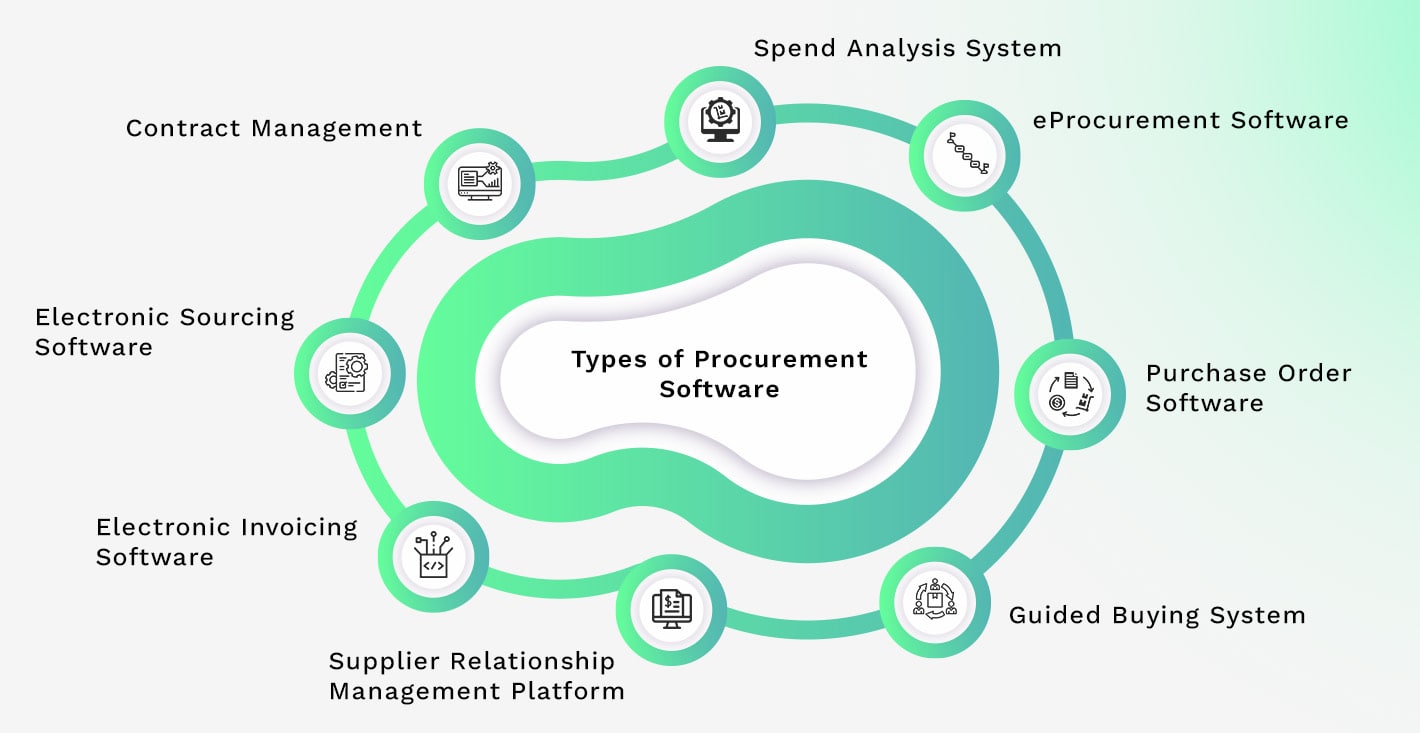
Benefits of Using Procurement Software
Procurement software for businesses offers several benefits.
1. Cost Reduction
Procurement software helps reduce costs by optimizing purchasing processes, identifying cost-saving opportunities, and negotiating better terms with suppliers. Automating repetitive tasks, streamlining workflows, and providing insights into spending patterns enables organizations to identify areas of excessive spending and implement strategies to reduce procurement costs. Additionally, procurement software helps negotiate favorable contracts and pricing with suppliers, leading to cost savings in the long run and improving the bottom line.
2. Cross-Organization Transparency
Procurement software promotes cross-organization transparency by providing visibility into procurement activities and expenditures across departments or divisions. It centralizes procurement data and standardizes processes, providing organizations with insights into spending patterns, supplier performance, and compliance with procurement policies. This transparency fosters collaboration and communication among stakeholders, resulting in better decision-making and risk management. Additionally, procurement software allows organizations to track the entire procurement lifecycle, from requisition to payment, to ensure accountability and traceability.
3. Workflow Standardization
Procurement software facilitates workflow standardization by automating and streamlining procurement processes. Defining standardized workflows and approval hierarchies ensures consistency and compliance with procurement policies and regulations. Procurement software enables the creation of predefined templates and rules for requisition, approval, sourcing, and contract management, reducing the risk of errors and delays. Standardized workflows make operations more efficient, speed up processes, and make them easier to track. This ensures smoother procurement management, minimizes delays, and makes it easier to adapt to changes in demand.
4. Scalability Potential
Procurement software offers scalability potential, allowing businesses to adapt and expand without outgrowing their procurement systems. It enables organizations to handle increasing transaction volumes, suppliers, and users as their operations expand. Companies can also add new features, users, or integrations as needed without significant disruptions or investments in new systems.
5. Purchasing Performance
Procurement software improves purchasing performance by streamlining and optimizing the procurement process. It provides visibility into purchasing activities, enabling organizations to track and analyze key performance metrics such as order accuracy, cycle times, and supplier performance. These detailed insights into purchasing performance enable businesses to identify bottlenecks, inefficiencies, and areas for improvement.
Optimizing purchasing processes with procurement software helps organizations reduce costs, minimize errors, and improve operational efficiency. Additionally, it empowers purchasing teams to make informed decisions, negotiate better terms with suppliers, and ultimately drive greater value for the organization.
6. Supplier Self-Service
Procurement software allows suppliers to directly interact with the procurement system using the Supplier Self-Service functionality. Suppliers can access important information, such as purchase orders, invoices, and payment statuses, without the need for manual intervention from procurement staff. This streamlines communication and collaboration between buyers and suppliers, reducing administrative overhead and enhancing efficiency. Suppliers can also submit bids, update product catalogs, and manage their profiles, ensuring that their information is accurate and up to date.
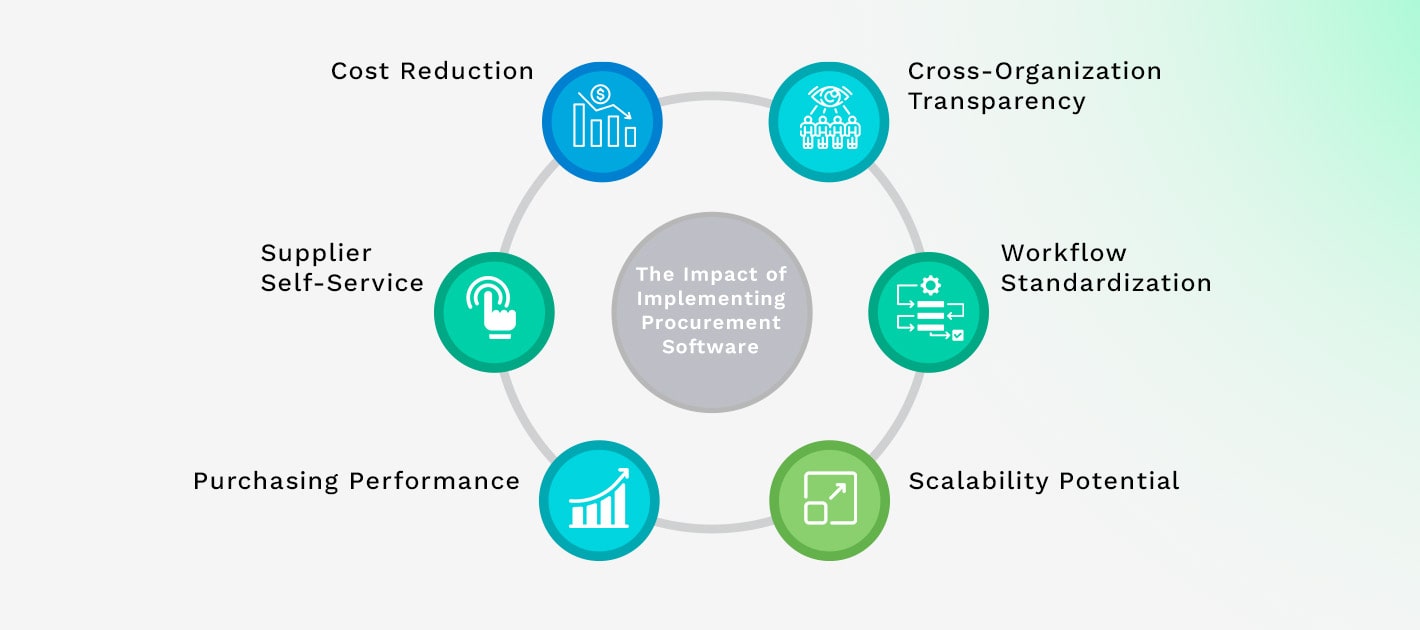
Features to Look for in Procurement Software
1. Accounting Automation
The Accounting Automation feature streamlines the financial aspects of procurement by automating tasks such as invoice processing, payment reconciliation, and budget tracking. This helps organizations reduce manual errors and streamline financial workflows, resulting in faster processing times and improved accuracy in financial reporting. Additionally, automated accounting processes help ensure compliance with financial regulations and auditing standards, providing organizations with greater confidence in their financial operations.
2. Curation Options
These tools allow users to curate and manage catalogs of goods and services from preferred suppliers. Customizable catalog management capabilities enable organizations to tailor their procurement processes to their specific needs and preferences. Users can easily search, filter, and compare items, ensuring they select the most suitable products at the best prices. Additionally, curation options facilitate supplier relationship management by allowing users to maintain accurate and up-to-date catalogs, fostering collaboration and transparency between buyers and suppliers.
3. Flexible Workflows
Flexible workflows empower organizations to customize and adapt their procurement processes to meet their unique business requirements. They enable users to easily design, automate, and optimize procurement workflows to streamline operations and improve efficiency. Whether it's defining approval hierarchies, setting up routing rules, or configuring notifications, flexible workflows enable organizations to tailor their procurement processes to match their internal policies and procedures.
4. Intuitive Design
An intuitive interface ensures that users can navigate the software effortlessly, reducing the learning curve and increasing productivity. Intuitive design makes tasks such as creating purchase orders, managing suppliers, and tracking expenses easy and straightforward. Clear layout, logical navigation, and user-friendly controls contribute to a positive user experience, making it easier for procurement professionals to perform their daily tasks efficiently. Prioritizing intuitive design helps organizations enhance user satisfaction, minimize errors, and maximize the benefits of their procurement software investment.
5. Integrations
Seamless integration capabilities enable interoperability with other business systems and tools. The ability to integrate with existing ERP systems, accounting software, inventory management solutions, and supplier databases streamlines processes and data flow across the organization. Robust integration options help procurement teams eliminate silos, reduce manual data entry, and ensure data consistency and accuracy. Moreover, integrations facilitate real-time data sharing, enabling stakeholders to make informed decisions based on up-to-date information.
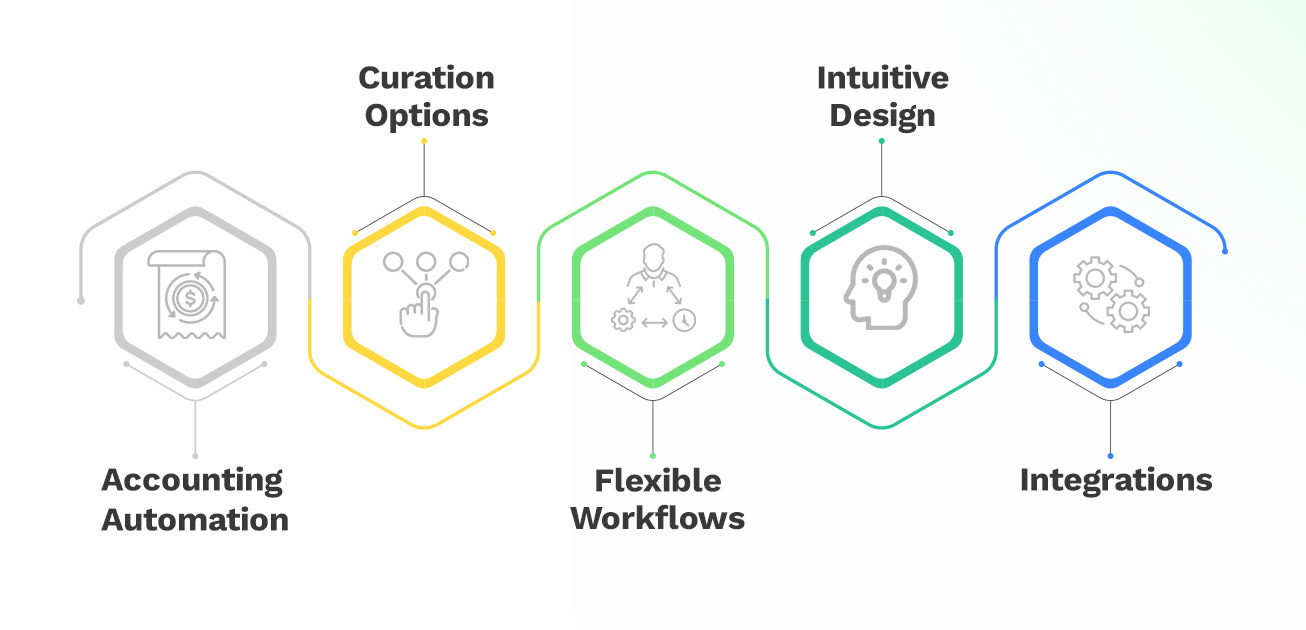
Kohezion: The Most Reliable Procurement Software for Your Business
Kohezion stands out as the go-to option for dependable procurement software solutions. Our platform offers customizable features designed to address the unique requirements of your business. Simplify your procurement processes, track expenses effectively, and make informed decisions with our user-friendly interface and powerful tools. Whether you're a small startup or a large corporation, Kohezion is here to support your procurement needs. Get in touch with us today to explore how our solutions can be customized to suit your needs.
Conclusion
Procurement software stands as a vital tool for businesses that want to improve efficiency and accuracy in their purchasing processes. This software enables organizations to optimize their procurement operations by automating tasks, managing supplier relationships, and providing valuable insights through data analytics.
Integrated with ERP systems or other platforms, procurement software offers a unified approach to managing the procure-to-pay cycle, ensuring consistency and compliance with company policies. Investing in robust procurement software is essential for businesses that navigate complex procurement landscapes to stay competitive and drive growth.
Start building with a free account
Frequently Asked Questions
Procurement software streamlines and automates the process of sourcing, purchasing, and managing goods and services for businesses. It provides a centralized platform for all procurement-related activities, including supplier management, contract management, purchase requisitions, purchase orders, invoicing, and payments.
Digitizing these processes improves efficiency, accuracy, and transparency throughout the procurement lifecycle. It allows businesses to track spending, negotiate better deals with suppliers, ensure compliance with procurement policies and regulations, and optimize their procurement strategies for cost savings and operational excellence.
Yes, small businesses can benefit significantly from using procurement software. While modern procurement software solutions are traditionally viewed as tools for larger enterprises, they are increasingly accessible and scalable, making them suitable for businesses of all sizes.
Procurement software helps small businesses streamline their purchasing processes, manage supplier relationships more effectively, and gain better visibility into their spending. Automating routine tasks and providing insights into spending patterns enables small businesses to operate more efficiently, reduce costs, and make informed purchasing decisions. Additionally, it can help small businesses stay compliant with regulations and industry standards, fostering growth and competitiveness in the marketplace.
Procurement software typically offers various integration options to seamlessly connect with existing systems. These integrations enable data sharing and synchronization between procurement software and other business applications, such as accounting systems, ERP software, inventory management tools, and supplier databases.
Integration capabilities may include APIs, pre-built connectors, or custom integration solutions tailored to specific business needs. Integration with existing systems ensures data consistency, eliminates manual data entry errors, and enhances overall operational efficiency. Additionally, integration facilitates real-time visibility into procurement processes and enables better decision-making across the organization.
Common challenges organizations face when implementing procurement software include resistance to change among employees, data migration issues, lack of user training, and difficulty in aligning procurement processes with the software's capabilities.
Resistance to change can arise due to employees' familiarity with existing processes and reluctance to adopt new technologies. Data migration challenges may include transferring large volumes of data from legacy systems to the new software while ensuring data integrity and accuracy. Insufficient user training can lead to underutilization of the software's features and functionalities, limiting its effectiveness. Moreover, aligning procurement processes with the software's capabilities requires careful planning and customization to ensure a seamless transition and optimal system performance.
Addressing these challenges proactively through effective change management, robust data migration strategies, comprehensive user training, and customization efforts can help organizations successfully implement procurement software and realize its benefits.
Procurement software differs from a traditional system in several key ways. Firstly, procurement software offers centralized access to procurement-related data and processes, allowing for greater visibility and control over purchasing activities. In contrast, traditional systems often rely on manual or disjointed processes, leading to inefficiencies and inaccuracies.
Additionally, procurement software typically includes features such as automated workflows, supplier management tools, and analytics capabilities, which enhance efficiency and decision-making. Traditional systems, on the other hand, rely more heavily on manual intervention. Furthermore, procurement software is often cloud-based, providing flexibility and scalability compared to on-premises traditional systems.
Overall, procurement software represents a modernized approach to procurement management, offering enhanced functionality, efficiency, and adaptability compared to traditional systems.
